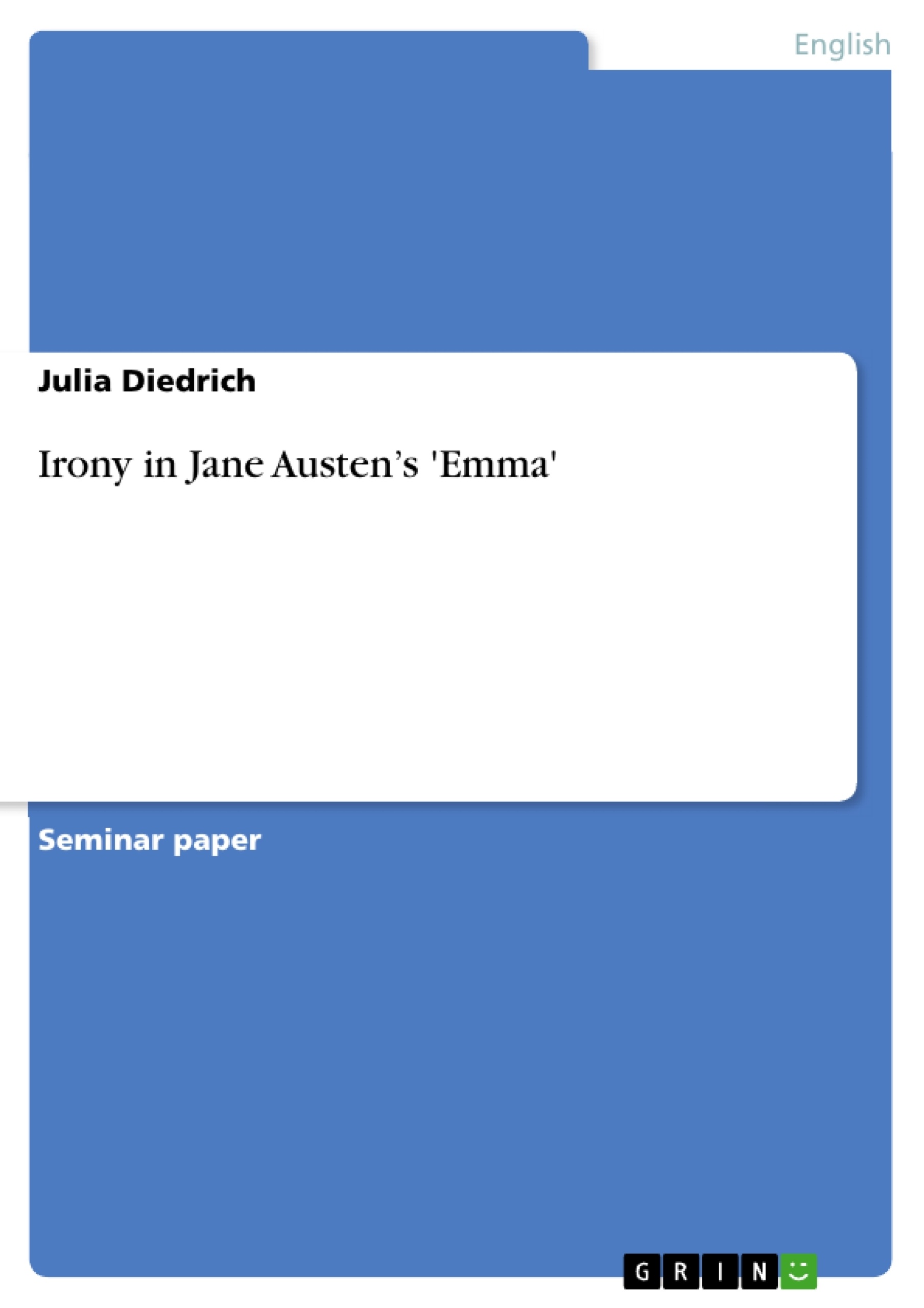Many critics still regard Jane Austen as one of the “most popular and enduring English writers of all time” (Byrne 20). Throughout the literary world, she is renowned for her skills in novel writing (cf. Trickett 162). Among other qualities, Austen has particularly been acknowledged for being a “dazzling satirist of snobbery and elitism” (Byrne 2). Concerning her novels, Emma, being published in 1816, is nowadays seen as Austen’s greatest achievement (cf. Mansell 146). Even early critics acknowledged that the special nature of this novel in comparison to what she had written before (cf. Byrne 32). According to Odmark, Emma particularly reflects how Austen successfully established and further developed methods of writing used in her earlier novels (cf. Odmark 24). The success of Emma can also be seen in the fact that it was the first of Austen’s novels which was reviewed by a famous author of her time, Sir Walter Scott (1771-1832) (cf. Byrne 32). Scott particularly pointed to the “naturalness” and “pervasive realism” Austen employed in Emma (Trickett 163). However, he also claimed that this novel had not much of a story in the traditional narrative sense (cf. Trickett 168). While the climax of a story is normally reached through a number of incidents and adventures, Austen’s Emma does not present such features (cf. Trickett 168). What is most important about this novel was summed up by the novelist Thomas Henry Lister, who praised Austen for her “rare and difficult art of making her readers intimately acquainted with the characters” of her novel (qtd. in Trickett 165). He moreover stated that Austen’s novel provides the feeling of having literally lived among these characters; “and yet she employs no elaborate description – no metaphysical analysis – no antithetical balance of their good and bad qualities. She scarcely does more than make them act and talk [...].” (qtd. in Trickett 165). In Emma, the characters themselves are thus more important than the plot in the traditional sense. This is why critics often categorize Emma and other works by Austen as “novels of manners” (Marsh 28). In a novel of manners, the writer scrutinizes and minutely presents the characters’ behaviour (cf. Marsh 28). These specific manners, in turn, serve to reflect the characters’ moral attitudes (cf. Odmark 11). By analysing these, the reader is thus enabled to understand the deeper structure of the novel and the inner-lying messages of it (cf. Marsh 28)...
Inhaltsverzeichnis (Table of Contents)
- Introduction
- The concept of irony
- Body
- A general characterisation of Emma Woodhouse
- Irony in the “Emma-Elton-Harriet-fiasco”
- Irony in the “Emma-Frank Churchill-Jane Fairfax illusion”
- Conclusion
Zielsetzung und Themenschwerpunkte (Objectives and Key Themes)
This paper examines the use of irony in Jane Austen’s novel *Emma*, focusing on the protagonist's personality and her misjudgments of characters and situations. It aims to analyze how irony shapes the narrative and reveals deeper meanings within the story. * The concept of irony and its evolution in literature. * Emma Woodhouse's characterization and her role in the novel's ironic framework. * The interplay of irony in specific situations and relationships within the novel, such as the "Emma-Elton-Harriet-fiasco" and the "Emma-Frank Churchill-Jane Fairfax illusion". * The relationship between irony, aesthetic distance, and the novel's narrative voice.Zusammenfassung der Kapitel (Chapter Summaries)
This section summarizes the main themes and arguments presented in the chapters, excluding the final chapter and conclusion to avoid spoilers. * **Introduction**: This section provides a general overview of Jane Austen’s work and places *Emma* within the context of her other novels, highlighting its unique qualities and its critical reception. It introduces the concept of "novels of manners" and the theme of self-deception prevalent in Austen’s writing. * **The concept of irony**: This section delves into the origins and development of the concept of irony, tracing its evolution from the Greek term "eironeia" to its modern usage in literature. The author emphasizes the importance of interpreting irony as a multi-layered phenomenon, involving both spoken and unspoken meanings. * **Body**: This section explores specific examples of irony in *Emma*, focusing on the protagonist's character and her misinterpretations of events. It examines how the interplay of irony reveals the deeper structure of the novel and its underlying messages. The author discusses the "typical ironic pattern" within the story and the "series of ironic discrepancies" between the characters' speech, thoughts, and feelings.Schlüsselwörter (Keywords)
This paper explores the use of irony, aesthetic distance, and free indirect discourse within the framework of Jane Austen's *Emma*. The analysis focuses on the character of Emma Woodhouse and her misjudgments, revealing the interplay between appearance and reality. Key themes include self-deception, societal norms, and the complexities of human relationships.- Quote paper
- Julia Diedrich (Author), 2008, Irony in Jane Austen’s 'Emma', Munich, GRIN Verlag, https://www.hausarbeiten.de/document/189300


